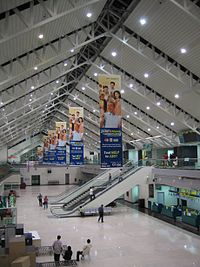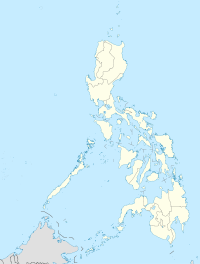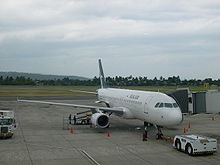- Francisco Bangoy International Airport
-
Francisco Bangoy International Airport
Paliparang Pandaigdig ng Francisco Bangoy
Tugpahanang Pangkalibutanon sa Francisco Bangoy
Inside the Davao International Airport terminal IATA: DVO – ICAO: RPMD Location of airport in Philippines Summary Airport type Public Operator Civil Aviation Authority of the Philippines Serves Davao City Location Barangay Sasa, Buhangin, Davao City Hub for Cebu Pacific
Airphil ExpressElevation AMSL 18 m / 59 ft Coordinates 7°7′31.88″N 125°38′44.80″E / 7.1255222°N 125.645778°E Runways Direction Length Surface m ft 05/23 3,000 9,842 Asphalt concrete Statistics (2010) Passengers 2,664,210 Aircraft movements 19,198(2,009) Metric tonnes of cargo 34,257(2,009) Statistics from the Civil Aviation Authority of the Philippines.[1] Francisco Bangoy International Airport (Filipino: Paliparang Pandaigdig ng Francisco Bangoy, Cebuano: Tugpahanang Pangkalibutanon sa Francisco Bangoy), also called Davao International Airport (IATA: DVO, ICAO: RPMD), is the main airport serving Davao City in the Philippines. It is the busiest airport in the island of Mindanao. The airport has a single 3,000-meter precision runway.
A new terminal replaces the previous airport terminals, which lie just across it, in handling both domestic and international flights operating to and from Davao. The modern facility is designed to handle approximately 2 million passengers annually and 84,600 metric tons of cargo annually. The added capacity is also complemented by the latest navigational, security, and baggage handling equipment.
The modernization and upgrading of the airport facilities aims to cement Davao as a hub for tourism and foreign investment in the region. Development was funded by a forty million-dollar loan from the Asian Development Bank, co-financed by the European Investment Bank for twenty-five million ECUs, and through budgetary allocations from the government. The total cost of the project amounted to $128 million.
After almost a decade, the new terminal was finally inaugurated on December 2, 2003. Initial construction began in 2000 while plans for construction were announced in 1992.
On November 12, 2007, Cebu Pacific announced this airport as its third hub.[2]
Despite the fact that Davao International Airport is considered "international", it currently services only one international destination, Singapore. However, there are occasional charter flights to Davao from Manado, Indonesia by Wings Air and Davao from Seoul, South Korea by Jeju Air.[3] Cebu Pacific used to serve Davao-Hong Kong and Singapore, however these flights have been discontinued in 2009.[4] But an Executive Order of Pocket Open Skies Policy is now being reviewed by the Philippine Government which would allow foreign carriers to operate at Davao International Airport.[5]
Contents
History
Francisco Bangoy International Airport began operations in the 1940s with a donation of land in Barangay Sasa, located in the Buhangin district of Davao City, by Francisco Bangoy, the patriarch of an influential family residing in the city. At the time it began operation, the airport merely consisted of a 1,200-meter unpaved grass runway and quonset huts serving as terminal buildings. At the time, and throughout much of the 1940s and 1950s, both Philippine Airlines and the Philippine Air Force provided air service to the city.[6]
By 1959, the complex consisted of a small control tower and several low-rise buildings. A new terminal designed by Filipino architect Leandro Locsin, with a capacity of one million passengers, was constructed in 1980 and the runway was progressively extended from its original length of 1,200 meters to its current 3,000 meters. Both projects were funded during the term of then-Congressman Manuel Garcia, whose congressional district covers the airport perimeter.[6]
Rapid growth at the airport precipitated the construction of a P15 million interim international terminal beside the airport's then-existing terminal,[6] and then eventually a new, larger terminal building which would consolidate the two existing terminals. In planning since 1992, construction began in 2000 and subsequently inaugurated on December 2, 2003, with a capacity double that of the old airport terminal. The construction of the new P2.7 billion building was funded by both the Asian Development Bank and the European Investment Bank.[6]
Future Plans
Pocket Open Skies Policy
The Civil Aviation Authority of the Philippines (CAAP) said that it will immediately upgrade and modernize 5 alternate international airports in line with the administration’s call for “pocket open-skies” policy to attract more tourists. This includes Davao International Airport, among others. The 5 airports have existing frontline facilities related to Customs, Immigration and Quarantine. Airlines like Japan based All Nippon Airways, Korean Air subsidiary Jin Air and Air Asia Philippines showed interest in flying to these airports internationally.[7]
Old Airport will be rehabilitated
The old airport in Sasa might be reopened as a satellite facility to latch into the ASEAN connectivity program, an official of the Davao City Chamber of Commerce and Industry Inc. (DCCCII) revealed. Maria Lourdes G. Monteverde, president of DCCCII, said yesterday during the weekly Club 888 forum at Marco Polo Davao Hotel that it is one of the strategies brought up during a meeting with the Civil Aviation Authority of the Philippines area manager Frederick G. San Felix Jr. and tourism regional director Arturo P. Boncato Jr. last week. Monteverde added that they are ready with infrastructure, adding that the existing airport will also be rehabilitated.[8]
Planned Airlines
Four international budget airlines have signified their intention to service Davao City for direct flights in other Asian destinations. One airline plans to open direct flights between Davao City and Singapore,according to Sebastian L. Angliongto, chair emeritus of DCCCII, although he declined to give the name of the company.
Structure
Terminal
The P2.7 billion passenger terminal is a Malay architecture-inspired building which is four times larger than the old terminal. It is highly computerized, more secure and has more commercial spaces for concessionaries at approximately 9,000 sq. meter. It has four units of jet bridges for passengers. It has also a Flight Information Display System and Closed Circuit Television System complementing the terminal's security system.
The terminal has 14 domestic and 14 international check-in counters that can handle a steady flow of passenger traffic. The Check-in counters are equipped with electronic weighing scales and conveyors and its baggage handling system is also computerized. It also has 2 arrival areas, for domestic and international with 2 baggage conveyors each. The Cargo Terminal Building covers almost 5,580 sq. meters and can handle up to 84,600 metric tons of cargo a year.[9]
Runway
 The airport's Air Traffic Control Tower is considered as one of the most sophisticated in the Philippines.
The airport's Air Traffic Control Tower is considered as one of the most sophisticated in the Philippines.
The airport has a single 3,000-meter long runway that can handle wide-bodied aircraft such as the Airbus A330, the Airbus A340, Boeing 747 and even Airbus A380. The installation of a new instrument landing system (ILS) for both Runways 05 and 23 upgraded its compliance to International Civil Aviation Organization (ICAO) operating category-Precision Approach Category 1. It can accommodate 8-10 aircraft landings per hour, depending on size and has the equivalent 8 gate holding areas for those aircraft.[9] The airport has also 2 dual access taxiway [taxiway A3 and taxiway A4 is used to access the new ramp and terminal; taxiway B and taxiway C is used for access to the old airport ramp].[10]
Other structures
Besides the main terminal building, there are also new support facilities like the Administration Building, Airfield Maintenance Building, Central Plant Building, Hangar for Military and Training aircraft and Fire/Crash/Rescue Building. It has a 688-slot car parking area and 4 slots for shuttle buses. It has a 3-megawatt standby power generator. The Air Traffic Control tower is considered as the most advanced in the Philippines.[9] There are also 2 Mabuhay lounges of Philippine Airlines inside the airport premises.
Airlines and Destinations
Domestic Wing
Airlines Destinations Airphil Express Cagayan de Oro, Cebu, Iloilo, Manila, Zamboanga Cebu Pacific Cagayan de Oro, Cebu, Iloilo, Manila, Zamboanga Mid-Sea Express Bislig [begins January 15], Tagbilaran [begins December 18] Philippine Airlines Manila Zest Airways Manila International Wing
Airlines Destinations SilkAir Singapore[note 1] Tiger Airways Singapore ;Notes
Statistics
Year Domestic International Passenger
MovementsAir-freight
(tons)Aircraft
MovementsPassenger
MovementsAir-freight
(tons)Aircraft
Movements2004 854,754 32,515,758 8,634 16,721 --- 230 2005 1,322,064 50,372,167 14,112 20,635 --- 370 2006 1,307,635 40,753,487 12,928 46,833 --- 517 2007 1,502,600 45,522,243 13,754 29,644 15,455 499 2008 1,646,347 53,287,642 15,178 43,530 14,931 409 2009 1,935,454 34,172,210 18,746 32,496 84,429 452 2010 2,664,210 Source:[11]
Accidents and Incidents
- On April 19, 2000, Air Philippines Flight 541, a Boeing 737-200 en route from Manila to Davao crashed near the airport killing 131 people.[12][13]
- On March 4, 2003, a bomb exploded in the waiting shed outside the old terminal building, killing 21 people. At least 145 others were injured when the bomb went off.[14]
- On the night of August 25, 2008, a Philippine Air Force, C-130 Hercules bound for Iloilo City crashed into Davao Gulf shortly after take off from Davao International Airport. The aircraft sank 800 ft. into the gulf. After several days of a search-and-retrieval operation, the heavy transport aircraft was found with the help of a US Naval Ship. The incident killed all crew on board including 2 Philippine Army soldiers.
See also
References
- ^ "Passenger Statistics 2009". May 14, 2010. http://www.caap.gov.ph/Downloads/adms.pdf. Retrieved April 21, 2009.
- ^ "Cebu Pacific to make Davao its 3rd hub" (Press release). Cebu Pacific. 2007-11-12. http://www.cebupacificair.com/aboutus/press/2007/11122007.html. Retrieved 2007-11-12.
- ^ Which Airlines fly to Francisco Bangoy International Airport
- ^ http://airlineroute.net/2008/08/08/cebu-pacific-to-restart-planned-davao-hub/
- ^ http://www.gmanews.tv/story/209768/palace-to-issue-eo-on-open-skies-policy-this-week Palace to issue EO on open skies policy this week
- ^ a b c d Ajero, Antonio M. (2003-12-01). "Nonoy Garcia, Elias Lopez and other airport tales". Sun.Star Davao. http://www.sunstar.com.ph/static/dav/2003/12/01/feat/nonoy.garcia.elias.lopez.and.other.airport.tales.html. Retrieved 2008-12-14.
- ^ http://www.abs-cbnnews.com/business/01/20/11/5-airports-set-upgrade-under-pocket-open-skies 5 airports set for upgrade under pocket open skies.
- ^ http://www.skyscrapercity.com/showthread.php?t=1427070&page=18
- ^ a b c "Upgraded Davao City International Airport Is Ready for More Passengers and Bigger Aircraft"
- ^ http://www.caap.gov.ph/web/airportsDavao.htm
- ^ CIVIL AVIATION AUTHORITY OF THE PHILIPPINES AERODROME DEVELOPMENT & MANAGEMENT SERVICE
- ^ Air disaster timeline. BBC. November 30, 2007. http://news.bbc.co.uk/1/hi/world/2008892.stm. Retrieved 2008-06-01
- ^ Accident description. Aviation Safety Network. April 19, 2000. http://aviation-safety.net/database/record.php?id=20000419-. Retrieved 2008-06-01
- ^ "CNN.com - Airport bomb suspects held - Mar. 4, 2003". http://www.cnn.com/2003/WORLD/asiapcf/southeast/03/04/philippines.bomb/index.html.[dead link]
External links
- - AECOM
- World Aero Data - Francisco Bangoy International Airport (DVO) Details
- What's On & Expat Magazine, June 18, 2006 - Upgraded Davao City International Airport Is Ready for More Passengers and Bigger Aircraft
- Current weather for RPMD at NOAA/NWS
- Airport information for RPMD at World Aero Data. Data current as of October 2006.Source: DAFIF.
- Airport information for DVO / RPMD at Great Circle Mapper. Source: DAFIF (effective Oct. 2006).
- Accident history for DVO / RPMD at Aviation Safety Network
 Airports in the Philippines
Airports in the PhilippinesInternational airports Angeles (CRK) • Cebu (CEB) • Davao (DVO) • General Santos (GES) • Iloilo (ILO) • Kalibo (KLO) • Laoag (LAO) • Manila (MNL) • Olongapo (SFS) • Puerto Princesa (PPS) • Zamboanga (ZAM)
Major domestic airports Minor domestic airports Alcantara (TBH) • Baguio (BAG) • Basco (BSO) • Bongao (SGS) • Busuanga (USU) • Calbayog (CYP) • Catarman (CRM) • Cuyo (CYU) • Del Carmen (IAO) • Gasan (MRQ) • Jolo (JOL) • Malay (MPH) • Mambajao (CGM) • Masbate (MBT) • Ormoc (OMC) • San Jose (Antique) (EUQ) • Surigao (SUG) • Tandag (TDG) • Virac (VRC)
Community airports Bagabag (RPUZ) • Baler (BQA) • Bantayan (RPSB) • Bislig (BPH) • Borongan (BPR) • Wao
Unclassified and
notable aerodromesAirports in italics have not yet been opened, are under construction, or are in the planning stages. Transportation in the Philippines Transportation agencies Public utility vehicles Bus companies AB Liner · ALPS The Bus, Inc. · Baliwag Transit · Bonifacio Transport Corp. · CEM Trans Services, Inc. · Ceres Liner · Citylink Coach Services Inc. · Dagupan Bus Co., Inc. · De Leon Express · Dela Rosa Transit · DLTBCo · Dominion Bus Lines · EMBC · Farinas Transit Company · Fermina Express · Five Star Bus Company · G Liner · Genesis Transport Service Inc. · Greenline Express · Green Star Express Inc. · GV Florida Transport · HM Transport Inc. · Inocencio Aniceto Transportation · JAC Liner Inc. · JAM · Joanna Jesh Transport Corp. · Juaymah Maureen Transport · King of Kings Transport · Lilian Express · Partas · Peñafrancia Tours and Travel Transport Inc. · Philippine Rabbit · Philtranco · Santrans · Saulog Transit Inc. · Vallacar Transit Corporation · Victory Liner · Viron TransitMajor highways A. Soriano Highway · Aguinaldo Highway · C-5 · Commonwealth Avenue · EDSA (C-4) · Governor's Drive · Halsema Highway · MacArthur Highway · Maharlika Highway · Manila-Cavite Expressway (Coastal Road) · Marikina-Antipolo Highway · NAIA Expressway · North Luzon (NLEx) · Quirino Highway · Sayre Highway · Subic-Clark-Tarlac (SCTEx) · Skyway · South Luzon (SLEx) · Southern Tagalog Arterial Road (STAR Tollway)Railways International airports Airlines Air Philippines · Cebu Pacific · Interisland Airlines · Pacific Pearl Airways · Philippine Airlines · PAL Express · Sky Pasada · South East Asian Airlines · Spirit of Manila · Tair Airways · Zest AirwaysWater transportation Shipping lines Cebu Ferries · Cokaliong Shipping Lines · Gothong Lines · Gothong Southern · Lite Shipping Corporation · Montenegro Lines · Negros Navigation · Roble Shipping Inc. · Sulpicio Lines · SuperFerry · Supercat Fast Ferry Corporation · Trans-Asia Shipping LinesCars of the Philippines Categories:- Airports in the Philippines
- Davao del Sur
Wikimedia Foundation. 2010.




